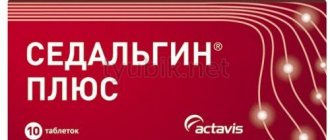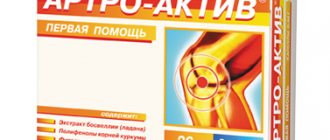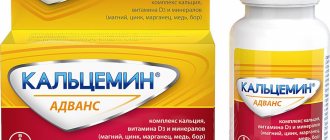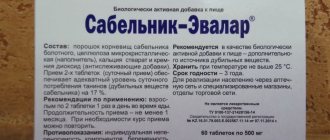Composition and release form
The composition of the drug depends on the form of release of the drug. Eufillin is produced in the following versions:
- Pills. One piece contains the active substance - aminophylline (150 milligrams), as well as auxiliary components. The latter include calcium, stearic acid and potato starch.
- Ampoules (solution for injection). Aminophylline is also the main substance. Each ampoule contains 24 milligrams of the active ingredient. In addition to it, the composition also contains water for injection.
special instructions
The bronchodilator effect of the drug occurs when the concentration of the active substance reaches 0.01-0.02 mg/ml. A concentration exceeding 0.02 mg/ml is toxic.
The stimulating effect on the respiratory center is realized when the content of aminophylline in the blood is in the range from 0.005 to 0.01 mg/ml.
In newborn infants and people over 55 years of age, the medicine is used with caution due to the insufficient activity of the liver enzymatic systems involved in the biotransformation of aminophylline .
In geriatrics, aminophylline should be used in minimal doses while monitoring the plasma concentration of aminophylline .
During the treatment period, you should not eat foods that contain xanthine derivatives: mate, chocolate, coffee, cocoa, strong tea.
The solution is heated to body temperature before administration.
Pharmacological effects
The main effect of the drug is antispasmodic. However, it also has other effects on the human body, namely tocolytic, diuretic and bronchodilator.
According to the Vidal classifier, Eufillin is included in the pharmacological group of phosphodiesterase inhibitors.
What does Eufillin help with? Indications for use
Indications for use of the drug Eufillin may vary slightly depending on the form of release. Tablets are most often prescribed for:
- Bronchial asthma of varying severity.
- Chronic obstructive pulmonary disease.
- Paroxysmal attacks of apnea at night.
- Right ventricular heart failure.
- Emphysema.
The injection form of the drug is used for:
- Cerebrovascular insufficiency of the brain (the drug is used in combination with other drugs and helps reduce intracranial pressure).
- Pulmonary hypertension.
- Left ventricular heart failure (also used in combination with a number of other drugs).
- For diseases of the respiratory system accompanied by spasm and broncho-obstructive syndrome (COPD, emphysema, bronchial asthma).
Eufillin during pregnancy
The manufacturer, in the instructions for Eufillin, warns that the use of solution/tablets during pregnancy may create concentrations of aminophylline and caffeine that are potentially hazardous to the health of the fetus/newborn.
Children whose mothers received the drug during pregnancy (especially in the third trimester) should be under medical supervision during the neonatal period to monitor possible symptoms of intoxication with methyl xanthine derivatives.
Prescription of Eufillin during pregnancy and lactation is possible only for extreme health reasons and requires an assessment of possible risks for the fetus/child.
Why can Eufillin be prescribed during pregnancy?
Gynecologists recommend the use of Eufillin for edema during pregnancy, for placental insufficiency, in the complex treatment of gestosis , as well as for other conditions that require urgent use of this medicine due to a threat to the life of the mother.
There is no clear treatment regimen for Eufillin during pregnancy, since the manufacturer’s instructions list pregnancy as one of the contraindications for use. The doctor makes all appointments depending on the condition of a particular patient.
Reviews of Eufillin during pregnancy allow us to conclude that the medicine is far from harmless (some women say that after the dropper they felt a strong heartbeat, weakness and dizziness), but for many it helps them to return to normal.
Contraindications
Eufillin is not a completely safe drug and has a fairly wide list of contraindications for its use:
- Individual hypersensitivity to one or more components of the drug.
- Children under 3 years of age.
- From the cardiovascular system: acute period of myocardial infarction, acute and severe chronic heart failure, atherosclerosis, dissecting aortic aneurysm, hypertrophic cardiomyopathy, high-grade arterial hypertension, and low blood pressure.
- From the digestive tract: exacerbation of gastric or duodenal ulcer, GERD, decompensated liver failure.
- Hormonal disorders: hypothyroidism, thyrotoxicosis.
- From the blood system: coagulation disorders and spontaneous bleeding in the anamnesis.
- Acute infectious diseases, sepsis.
- Severe renal failure.
- Epilepsy.
Side effects
When taking Eufillin, in addition to the main pharmacological action, side effects may also occur. Most often, patients develop insomnia, dizziness, weakness, tachycardia, arrhythmia, dyspeptic syndrome, allergic reactions, hypoglycemia, hypotension, increased sweating, pain in the head, chest and abdomen.
Against the background of a drug overdose, muscle cramps, increased body temperature, polyuria, hematuria, albuminuria and even disturbances of consciousness may occur.
To eliminate adverse symptoms, it may be necessary to reduce the dosage or stop taking the drug.
If the rules of asepsis and antisepsis are violated during injections of Eufillin, infectious complications sometimes develop.
Eufillin instructions for use
The single and daily dose of the drug is selected depending on the form of release, the disease and the age of the patient.
Adult patients are recommended to take 15 milligrams per kg of body weight 1 to 3 times a day. The pediatric dosage is 7-10 mg per kilogram of body weight 4 times a day. The course of treatment with tablets can vary from 3 days to several months.
When administered intravenously, the average daily dose ranges from 400 to 800 milligrams.
While taking the drug, it is necessary to monitor blood pressure, blood glucose and heart rate daily.
Eufillin 2.4%/5 ml No. 10 solution d/in.amp.
Instructions for medical use of the drug Eufillin Trade name Eufillin International nonproprietary name Aminophylline Dosage form Solution for intravenous administration 24 mg/ml, 5 ml Composition 1 ml of solution contains the active substance - aminophylline 24.0 mg excipient - water for injection Description Transparent, colorless or slightly colored liquid Pharmacotherapeutic group Drugs for the treatment of obstructive respiratory diseases. Other drugs for the treatment of obstructive airway diseases for systemic use. Xanthines Aminophylline ATX code R03DA05 Pharmacological properties Pharmacokinetics Bioavailability - 90-100%. The time to reach the maximum concentration in the blood plasma with intravenous administration is 0.3 g - 15 min, the maximum concentration in the blood plasma is 7 mcg / ml. The volume of distribution is in the range of 0.3-0.7 l/kg (30-70% of “ideal” body weight), with an average of 0.45 l/kg. Communication with plasma proteins in adults - 60%, in newborns - 36%, in patients with liver cirrhosis - 36%. Penetrates into breast milk (10% of the dose taken), through the placental barrier (the concentration in the fetal blood serum is slightly higher than in the maternal serum). Aminophylline exhibits bronchodilating properties in concentrations of 10-20 mcg/ml. Concentrations above 20 mg/ml are toxic. The stimulating effect on the respiratory center is realized at a lower content of the drug in the blood - 5-10 mcg/ml. Metabolized at physiological pH values with the release of free theophylline, which is further metabolized in the liver with the participation of several cytochrome P450 isoenzymes. As a result, 1,3-dimethyluric acid (45-55%) is formed, which has pharmacological activity, but is 1-5 times inferior to theophylline. Caffeine is an active metabolite and is formed in small quantities, with the exception of premature newborns and children under 6 months, in whom, due to the extremely long half-life of caffeine, its significant accumulation occurs in the body (up to 30% of that for aminophylline). In children over 3 years of age and in adults, the phenomenon of caffeine accumulation is absent. Half-life in newborns and children up to 6 months. — more than 24 hours; in children over 6 months - 3.7 hours; in adults - 8.7 hours; for “smokers” (20-40 cigarettes per day) – 4-5 hours (after quitting smoking, pharmacokinetics normalize after 3-4 months); in adults with chronic obstructive pulmonary diseases, pulmonary heart disease and pulmonary heart failure - over 24 hours. Excreted by the kidneys. In newborns, about 50% of theophylline is excreted unchanged in the urine versus 10% in adults, which is associated with insufficient activity of liver enzymes. Pharmacodynamics Bronchodilator, purine derivative; inhibits phosphodiesterase, increases the accumulation of cAMP in tissues, blocks adenosine (purine) receptors; reduces the flow of Ca2+ through the channels of cell membranes, reduces the contractile activity of smooth muscles. Relaxes the bronchial muscles, increases mucociliary clearance, stimulates contraction of the diaphragm, improves the function of the respiratory and intercostal muscles, stimulates the respiratory center, increases its sensitivity to carbon dioxide and improves alveolar ventilation, which ultimately leads to a decrease in the severity and frequency of apnea episodes. By normalizing respiratory function, it helps saturate the blood with oxygen and reduce the concentration of carbon dioxide. Strengthens ventilation of the lungs in conditions of hypokalemia. It has a stimulating effect on the activity of the heart, increases the strength and frequency of heart contractions, increases coronary blood flow and myocardial oxygen demand. Reduces the tone of blood vessels (mainly those of the brain, skin and kidneys). It has a peripheral venodilating effect, reduces pulmonary vascular resistance, and lowers pressure in the pulmonary circulation. Increases renal blood flow and has a moderate diuretic effect. Expands extrahepatic bile ducts. Stabilizes mast cell membranes, inhibits the release of mediators of allergic reactions. Inhibits platelet aggregation (suppresses platelet activating factor and PgE2 alpha), increases the resistance of red blood cells to deformation (improves the rheological properties of blood), reduces thrombus formation and normalizes microcirculation. It has a tocolytic effect, increases the acidity of gastric juice. When used in large doses, it has an epileptogenic effect. Indications for use - status asthmaticus (additional therapy) - cerebrovascular accident of ischemic type (as part of combination therapy) - left ventricular failure with bronchospasm and Cheyne-Stokes type breathing disorder Method of administration and dosage Adults: Intravenously administered slowly (over 4- 6 min) from 5-10 ml of a 24 mg/ml solution (0.12-0.24 g), which is pre-diluted in 10-20 ml of isotonic sodium chloride solution. If palpitations, dizziness, or nausea occur, the rate of administration is slowed down or switched to drip administration, for which 10-20 ml of a 24 mg/ml solution (0.24-0.48 g) is diluted in 100-150 ml of isotonic sodium chloride solution; administered at a rate of 30-50 drops per minute. Eufillin is administered parenterally up to 3 times a day, for no more than 14 days. Higher doses of aminophylline for adults: single - 0.25 g, daily - 0.5 g. In emergency conditions, adults are administered intravenously at a dose of 6 mg/kg, diluted in 10-20 ml of 0.9% NaCl solution, administered slowly over at least 5 min. For status asthmaticus, intravenous drip administration is indicated - 720-750 mg. Children: The drug is contraindicated in children under 14 years of age due to side effects. Higher doses for children from 14 to 18 years old intravenously - single 3 mc/kg, daily - 0.25 to 0.5 g. Side effects - dizziness, headache, insomnia, agitation, anxiety, irritability, tremor, fever, feeling of flushing in the face - palpitations, tachycardia, arrhythmia, decreased blood pressure, up to collapse (with rapid intravenous administration), cardialgia, increased frequency of angina attacks - gastralgia, diarrhea, nausea, vomiting, gastroesophageal reflux, heartburn, exacerbation of peptic ulcer, diarrhea , loss of appetite (with long-term use) - skin rash, itching, increased sweating - induration, hyperemia, pain (at the injection site) - chest pain, tachypnea - hypoglycemia - increased diuresis, albuminuria, hematuria The incidence of side effects decreases with decreasing dose drug. Contraindications - children under 14 years of age - hypersensitivity (including to other xanthine derivatives: caffeine, pentoxifylline, theobromine) - epilepsy - severe arterial hyper- or hypotension - severe tachyarrhythmias - hemorrhagic stroke - retinal hemorrhage With caution: pregnancy , age over 55 years and uncontrolled hypothyroidism (possibility of cumulation), sepsis, prolonged hyperthermia, gastroesophageal reflux, peptic ulcer of the stomach and duodenum (history), prostate adenoma. Drug interactions Ephedrine, beta-agonists, caffeine and furosemide enhance the effect of the drug. In combination with phenobarbital, diphenin, rifampicin, isoniazid, carbamazepine or sulfinpyrazone, a decrease in the effectiveness of aminophylline is observed, which may require an increase in the doses of the drug used. The clearance of the drug is reduced when prescribed in combination with macrolide antibiotics, lincomycin, allopurinol, cimetidine, isoprenaline, beta-blockers, which may require a dose reduction. Oral estrogen-containing contraceptives, antidiarrheal drugs, intestinal sorbents weaken, and H2-histamine blockers, slow calcium channel blockers, mexiletine enhance the effect (they are associated with the cytochrome P450 enzymatic system and slow down the metabolism of aminophylline). When used in combination with enoxacin and other fluoroquinolines, the dose of aminophylline is reduced. The drug suppresses the therapeutic effects of lithium carbonate and beta-blockers. The prescription of beta-blockers interferes with the bronchodilatory effect of aminophylline and can cause bronchospasm. Eufillin potentiates the effect of diuretics by increasing glomerular filtration and reducing tubular reabsorption. With caution, aminophylline is prescribed simultaneously with anticoagulants, other theophylline or purine derivatives. It is not recommended to use aminophylline with drugs that excite the central nervous system (increases neurotoxicity). The drug cannot be used with dextrose solutions and is not compatible with glucose, fructose and levulose solutions. The pH of the mixed solutions should be taken into account: pharmaceutically incompatible with acid solutions. Increases the likelihood of developing side effects of glucocorticosteroids, mineralocorticosteroids (hypernatremia), and general anesthesia agents (the risk of ventricular arrhythmias increases). When used simultaneously with enoxacin, small doses of ethanol, disulfiram, fluoroquinolones, recombinant interferon alpha, methotrexate, mexiletine, propafenone, thiabendazole, ticlopidine, verapamil and with influenza vaccination, the intensity of action of aminophylline may increase, which may require a reduction in its dose. Special instructions The drug is prescribed with caution, under constant medical supervision, to patients: - with severe impairment of liver and kidney function (liver and/or renal failure) - gastric and duodenal ulcers (history), with bleeding from the gastrointestinal tract into recent history - with severe coronary insufficiency (acute phase of myocardial infarction, angina pectoris) - with widespread vascular atherosclerosis - with hypertrophic obstructive cardiomyopathy - with frequent ventricular extrasystole - with increased convulsive readiness - with uncontrolled hypothyroidism (possibility of cumulation) or thyrotoxicosis - with prolonged hyperthermia - with gastroesophageal reflux - with prostate hypertrophy. Elderly patients are advised to reduce the dose of the drug due to delayed elimination from the body. Smoking patients are advised to increase the dose due to the accelerated elimination of the drug from the body. Pregnancy and lactation The use of aminophylline during pregnancy can lead to the creation of potentially dangerous concentrations of theophylline and caffeine in the body of the fetus and newborn. Newborns whose mothers received aminophylline during pregnancy (especially the third trimester) require medical supervision to monitor possible symptoms of methylxanthine intoxication. Prescribing the drug during pregnancy requires a careful assessment of the benefits for treating the mother and the potential risk to the fetus, and is carried out only for extreme health conditions. Breastfeeding should be discontinued while taking the drug. Features of the effect of the drug on the ability to drive a vehicle or potentially dangerous mechanisms Considering the possibility of developing side effects of the drug, during the treatment period you should refrain from driving vehicles and engaging in potentially hazardous activities that require increased concentration and speed of psychomotor reactions. Overdose: Symptoms: anorexia, diarrhea, nausea, vomiting, epigastric pain, gastrointestinal bleeding, tachycardia, ventricular arrhythmia, tremor, generalized convulsions, hyperventilation, sharp decrease in blood pressure. Treatment: discontinuation of the drug, stimulation of its removal from the body (forced diuresis, hemosorption, plasma sorption, hemodialysis, peritoneal dialysis) and the prescription of symptomatic drugs. Diazepam (by injection) is used to relieve seizures. Barbiturates should not be used. In case of severe intoxication (eufillin content more than 50 g/l), hemodialysis is recommended. Release form and packaging Solution for intravenous administration 24 mg/ml. 5 ml in neutral glass ampoules. 10 ampoules are placed in a cardboard box. Each box contains instructions for medical use in the state and Russian languages and a knife for opening ampoules or an ampoule scarifier. When packaging ampoules with a break ring or break point, do not insert a knife for opening ampoules or an ampoule scarifier. Storage conditions Store in a place protected from light at a temperature of 15 C to 25 C. Keep out of the reach of children! Shelf life: 3 years Do not use after the expiration date indicated on the package. Conditions for dispensing from pharmacies By prescription 630028, Russia, Novosibirsk, st. Dekabristov, 275 tel., fax Registration certificate owner: OJSC "Novosibkhimpharm" 630028, Russia, Novosibirsk, st. Dekabristov, 275 tel.; fax Address of the organization receiving claims on the territory of the Republic of Kazakhstan from consumers regarding the quality of products (goods) Valenta Asia LLP, Almaty, Abay Ave., ug. st. Radostovtsa, 151/115, business office No. 1102 Tel./fax, E-mail
Reviews about the drug
Reviews of Euphylline, like any other medicinal drug, are very diverse on the Internet. However, most patients note its high effectiveness and rapid elimination of symptoms of the disease.
There are also negative reviews, but they are most often associated with the development of adverse reactions due to individual intolerance to a component of the drug or as a result of an incorrectly selected dosage.
Some patients use Eufillin in combination with Dimexide and a number of essential oils for weight loss and getting rid of cellulite. The effectiveness of the drug in this regard has not been proven, so it is impossible to objectively judge its effectiveness.
Attention! Before taking the medicine, consultation with a specialist is required. Only a doctor will be able to select the correct dosage of the drug, calculate the duration of the course of treatment and take into account all the indications and contraindications for taking Eufillin. Otherwise, there is a high risk of developing negative side effects.




